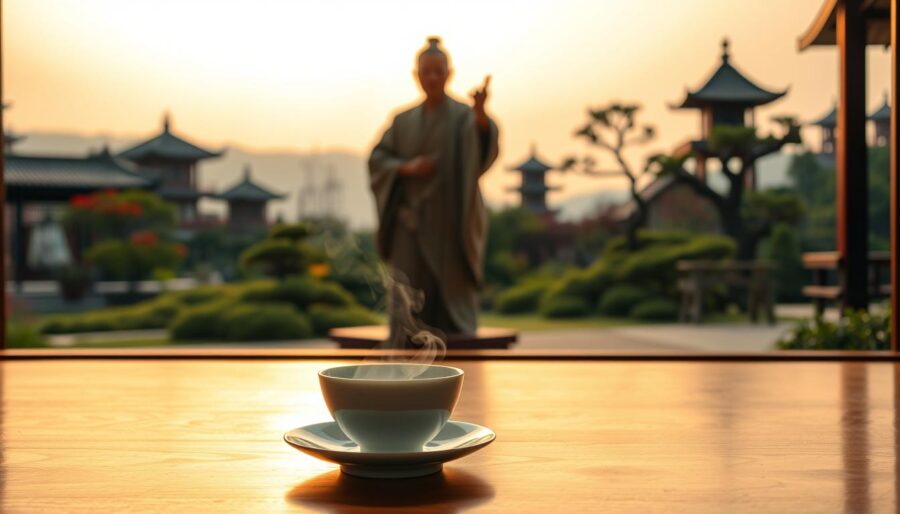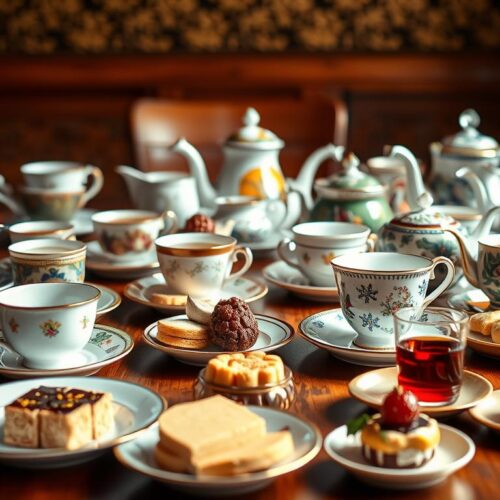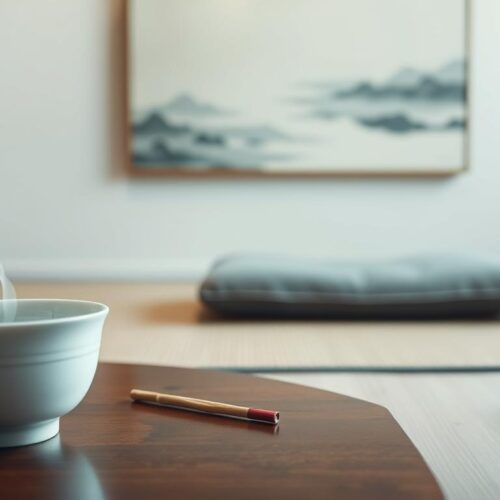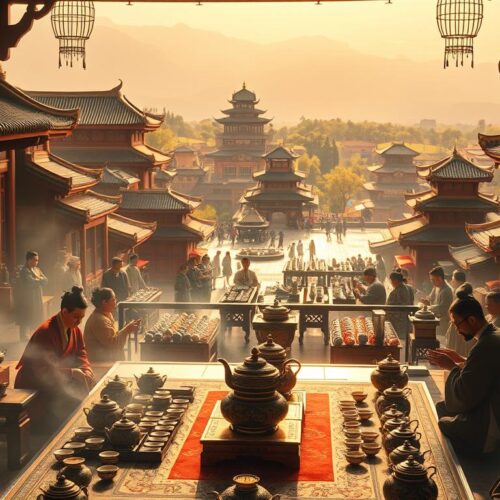Tea is more than just a refreshing drink. It stands as a deep symbol in art, poetry, and philosophy. As you dive into this topic, you’ll see how tea is tied to cultural rituals and deep thinking. In “The Book of Tea” by Kakuzo Okakura, tea goes beyond being just a drink. It represents purity, harmony, and beauty. Tea’s impact on art and literature is huge. It changes how people act and inspires creative conversations. Tea’s symbolism isn’t just personal; it touches on wide cultural stories. This makes it a fascinating subject to explore.
The Cultural Significance of Tea
Tea has been important for centuries across the world, especially in Eastern lands. It began as a medicine in old China. Now, tea stands for social peace and togetherness. Japan’s tea ceremony shows how tea evolved. It’s not just drinking; it’s about being mindful and connecting with nature.
Okakura talked about how Teaism teaches us to see beauty in everyday life. Tea isn’t just a drink. It’s a way to find calm and think deeply. Different places have made tea part of their traditions. This shows tea’s power to bring people together in spirit and community.
Tea as a Muse in Visual Arts
Tea has sparked creativity in many artists, leading to stunning tea-related art, paintings, and sculpture. These visual pieces often showcase the peaceful tea ceremonies. They show the beauty of tea sets and the calming practice of sipping tea. To many, a tea cup is more than just a drink holder. It’s a gateway from the normal to the magical, reflecting the thoughts of thinkers like Okakura.
In the art world, tea isn’t just something to look at. It stands as a deep symbol. Artists use tea scenes to talk about closeness and friendship, showing how tea brings people together. Looking at these art pieces, we see tea moments as special breaks, offering a peaceful spot in our busy lives.
Studying famous tea art, we see varied interpretations through time and cultures. Whether in ancient Chinese scrolls or modern art, tea symbolizes thoughtfulness and balance. It pulls us in, making us think about life and the natural world around us.
Symbolism of Tea in Literature
Tea in books is more than a drink; it’s a symbol that stirs emotions. It pops up in many genres and eras, suggesting comfort, tradition, and deep thought. Writers like Charles Lamb and Samuel Johnson have skillfully used tea’s symbolism. It helps explore what it means to be human. Sharing tea usually means community, linking people and showing their thoughts.
Tea in stories often reveals more about characters and their ties to others. A warm cup shared can mean friendship. A single teaspoon might show someone’s need to think alone. Scenes with tea let readers stop and think about big ideas, similar to tea drinking rituals.
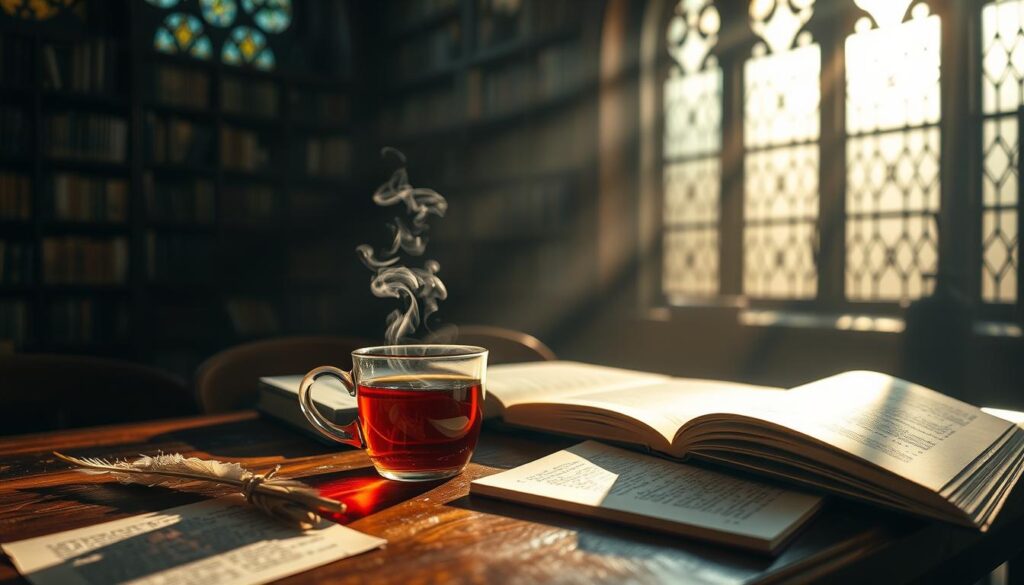
| Author | Work | Symbolism |
|---|---|---|
| Charles Lamb | “The Old and New Schoolmaster” | Tea as a comfort and social bond, illustrating the simplicity of life. |
| Samuel Johnson | “The Idler” | Tea signifying relaxation and a pause for thought amidst life’s chaos. |
| Virginia Woolf | “Mrs. Dalloway” | Tea ceremonies reflecting social structures and interpersonal dynamics. |
| Agatha Christie | “The Tea House on the Corner” | Tea representing the setting of mystery and discovery. |
Tea in literature shows us deep meanings beyond just drinking it. Authors use tea to deepen their stories. They add symbols that show emotions and human connections.
Philosophical Reflections on Tea
Tea is more than just a drink; it helps us think deeply and stay mindful. Kakuzo Okakura talked about how tea brings peace even when life is full. When we make and share tea, we often think about balance and peace, which are key to tea culture.
Thinking deeply about tea shows us more about ourselves and our quest for meaning. This simple act teaches us the value of clear thinking and a clean environment. Tea becomes not just a drink, but a ritual of respect and simplicity. These are important in many Eastern ways of thinking.
Tea has this ritual that lets us look inside ourselves. By taking time for tea, we reconnect with our thoughts and emotions. This helps us understand our role in the world better. Thus, drinking tea can spark important discussions and offer insights.
The Sensory Experience of Tea
Tasting tea is like exploring a rich world of flavors, smells, and sights. Every part of this experience adds to the joy of drinking tea. The act of making tea, with its rituals, starts the sensory journey even before the first sip.
Each sip of tea is a discovery of new tastes and smells. The aroma that fills the air during steeping invites us to enjoy the moment. With every drink, the mix of earthy to floral tastes blends perfectly with the inviting scents.
The look of the tea is just as important. The bright colors of various teas catch your eye and make the experience even better. By understanding these sensory aspects, you learn to love every second and truly appreciate the art of tea.
Tea in Modern Popular Culture
Tea has become a big part of modern culture, changing a lot over time. In the West, it got less popular as coffee took over. But now, there is a new interest in tea. People are choosing tea for health and wellness.
Artisanal and specialty teas are now very popular. This makes tea more than just a drink. Tea parties today mix old traditions with new styles. Many cities have tea houses offering different teas, like light oolongs and strong black teas.
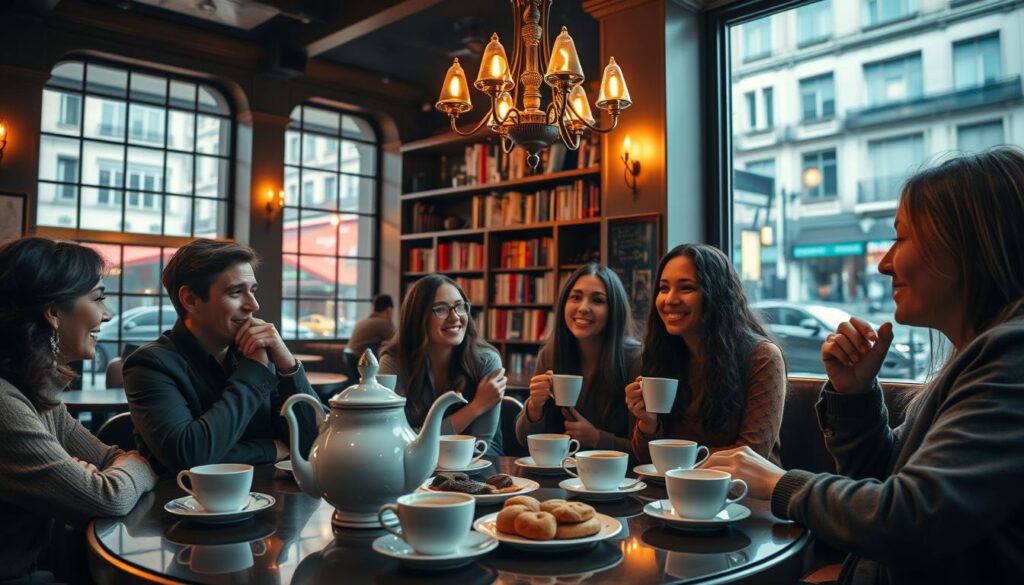
Afternoon tea is now a creative event in many places. These events show tea is still very important in our culture. People not only enjoy the teas but also the chance to connect with others.
In short, tea has a special role in today’s world. It encourages us to meet and share stories. Whether enjoying a classic tea or trying new trends, tea’s place in popular culture is strong and growing.
Bringing Tea into Your Creative Process
Adding tea to your creative routine can open up new ways to be inspired and focused. By creating tea rituals for inspiration, you make a special place for deep thought and new ideas. While making your tea, focus on its smell, color, and warmth. This helps you shift into a creative mindset.
Try setting times to drink tea when brainstorming or working on projects. Using tea for focus, pick teas that boost energy or soothe you, matching what you need. Many famous artists and writers used tea to spark their imagination. Embracing these rituals can deepen your artistry.
When you make tea, let your mind roam. Think about how your art ties to the fleeting life of tea leaves swirling in your cup. This brings calm and deepens the link between tea and creativity.
Turning this into a ritual is key. Set up a space that fits your art style. Pick your teaware, simple or fancy, with care. This adds meaning to your art process. These choices can help you connect more with your surroundings and boost your artistic output.
The Connection Between Tea and Social Interaction
Tea brings people together, fostering connections. Drinking tea in groups — be it formal or casual — sparks conversation. This shared ritual helps build stronger bonds and exchange ideas.
Gathering for tea shows hospitality and warmth, key in many cultures. It signifies a wish to bond and talk deeply. For example, inviting someone for tea often shows respect and a wish for meaningful conversation.
Tea connects different cultures over a shared cup. As you enjoy your tea, think about the cultural exchanges it represents. From Japanese ceremonies to Moroccan rituals, tea plays a key role in social bonds.
Conclusion: The Enduring Legacy of Tea in Art and Literature
The importance of tea goes way beyond just being a drink. For years, it has linked art and literature, inspiring many creators. Artists and writers have used tea to spark imagination and share experiences. This shows that tea is a worthy subject for exploration.
Think about how tea can stir strong feelings and boost creativity. Many find solace in the act of making and drinking tea, making it a source of beauty. Tea’s symbolism adds depth to art, whether in poems or paintings.
The lasting impact of tea in art and literature shows its key role in our world. As you explore your creativity, remember how tea evolves but stays rooted in history. It brings people together and adds to our artistic expressions. Tea remains a constant inspiration for all.

